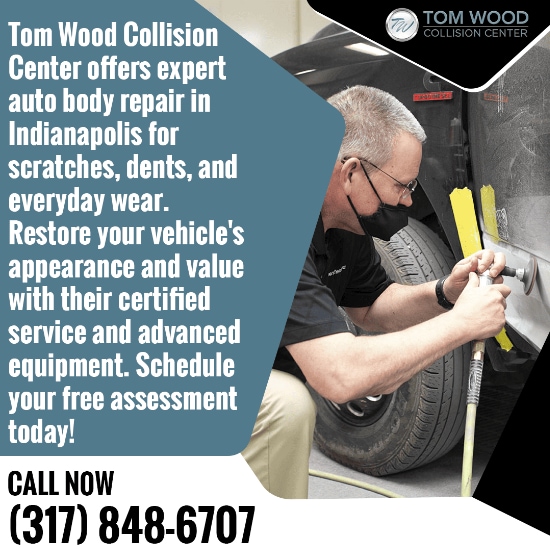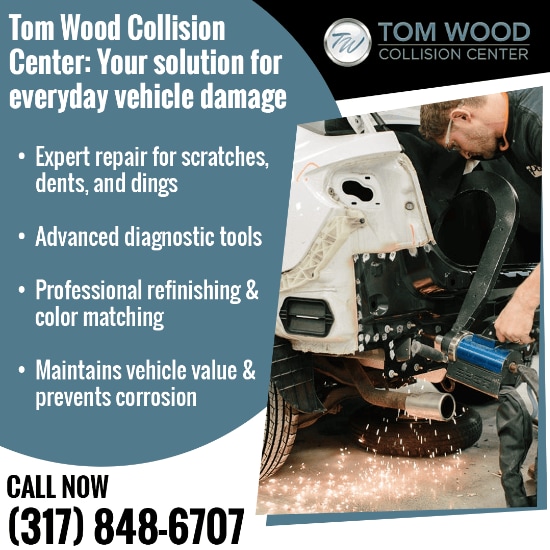Daily driving in Indianapolis exposes your vehicle to countless hazards. Whether it's a shopping cart at Target leaving a dent, road construction debris creating paint chips, or tight parking spaces causing scratches, minor damage accumulates over time. These seemingly small imperfections can quickly become expensive problems if left untreated.
Auto body repair for everyday damage requires specialized knowledge of modern paint systems and vehicle construction. Today's vehicles use multi-layer paint processes, advanced materials, and complex surface treatments that demand professional techniques to repair properly. What looks like simple surface damage often affects multiple layers that require specific restoration methods from a qualified auto body repair shop.
At Tom Wood Collision Center, our certified technicians understand how daily wear affects different vehicle makes and models. We provide targeted repair solutions that restore both appearance and protective function. As an established auto body repair shop in Indianapolis, we focus on the quality workmanship that everyday damage requires.

Typical Vehicle Damage From Regular Use
Vehicle damage can occur gradually through normal use and environmental exposure. Unlike collision damage from accidents, everyday damage accumulates over months and years of regular driving, parking, and weather exposure. Understanding these patterns helps vehicle owners recognize when professional auto body repair near you becomes necessary to maintain their investment.
Environmental Damage Factors
Indianapolis weather creates specific challenges for vehicle exteriors. Winter road salt accelerates paint degradation and metal corrosion, while summer heat causes paint to fade and become brittle. Spring storms bring hail and debris that can damage multiple vehicles simultaneously.
UV radiation from direct sunlight breaks down paint polymers over time, causing fading and oxidation. Vehicles parked outdoors experience more rapid paint degradation than those stored in covered areas. Clear coat failure often begins as small spots that expand if left untreated.
Urban Driving Hazards
City driving exposes vehicles to unique damage risks that suburban and rural drivers rarely encounter. Construction zones scatter gravel and debris that chips paint and cracks windshields. Heavy traffic creates more opportunities for minor contact between vehicles.
Parking in urban areas presents challenges from tight spaces, parallel parking situations, and higher pedestrian traffic. Shopping centers and office complexes concentrate vehicles in ways that increase door ding frequency and cart damage incidents.
Preventable vs Unavoidable Damage
Some everyday damage can be minimized through careful driving and parking choices, while other types remain largely unavoidable. Road debris from trucks and construction sites affects all vehicles regardless of driving habits. Weather damage occurs to vehicles regardless of the owner's precautions.
However, parking location choices can reduce certain damage types. End parking spaces limit door ding exposure to one side. Covered parking protects against hail and UV damage. Distance from shopping cart return areas reduces cart impact risks.
Common Scratches That Require Auto Body Repair
Scratches come in various forms and depths, each requiring different repair approaches. Understanding scratch types helps you determine when professional auto body repair becomes necessary versus when simple polishing might suffice. Most auto body repair shops categorize scratches by their depth and the repair methods required.
Clear Coat Scratches
Clear coat damage represents the most common type of everyday scratching. These surface-level marks affect only the protective top layer without penetrating to the colored paint underneath. Fingernail tests help identify clear coat scratches. If your nail doesn't catch when dragged across the mark, it's likely surface-level damage.
Clear coat scratches result from car washes with dirty sponges, wiping dust off dry surfaces, or light contact with vegetation. While minor clear coat damage can sometimes be polished out, larger areas or multiple scratches across panels typically require professional attention to achieve uniform results.
Paint Layer Scratches
Paint layer damage penetrates through the clear coat to the colored paint beneath. These scratches appear as white or light-colored lines on dark vehicles, or dark lines on light-colored cars. Paint scratches commonly occur from keys, shopping cart impacts, or contact with rough surfaces.
Paint layer scratches require careful color matching and blending techniques that most DIY approaches cannot achieve. Professional auto body repair shops use computerized color-matching systems and spray application methods to restore seamless paint appearance.
Primer and Metal Scratches
The deepest scratches penetrate through all paint layers to the primer or bare metal underneath. These damages appear as gray or silver lines and require immediate attention to prevent rust formation. Metal exposure allows moisture and salt to begin corrosion processes that spread beyond the original scratch area.
Deep scratches demand complete refinishing processes, including primer application, base coat matching, and clear coat protection. Attempting DIY repairs on primer or metal scratches often results in visible patchwork that reduces vehicle value more than the original damage. These repairs require the expertise that only a qualified auto body repair shop can provide.
Dent Types and Auto Body Repair Solutions
Dents vary in size, shape, and complexity, with each type requiring specific repair techniques. Modern auto body repair offers multiple approaches to dent removal, depending on damage characteristics and location.
Small Door Dings
Door dings from adjacent vehicles represent the most frequent dent type. These small, round impressions typically occur in parking lots where space constraints create contact opportunities. Most door dings affect only the outer panel without damaging paint or interior structures.
Paintless dent repair (PDR) works ideally for door dings when paint remains intact. Skilled technicians use specialized tools to massage dents out from behind panels, maintaining original factory paint. This process costs less than traditional bodywork and preserves vehicle value better than painted repairs.
Hail Damage Dents
According to industry data, hail damage represents a major portion of auto body repair work nationwide. CCC reported that 3.5% of all appraisals it processed on behalf of its customers in April 2021 were for vehicles damaged by hail. The Indianapolis area has experienced 140 reports of on-the-ground hail by trained spotters in the past 12 months, making hail damage a common concern for local vehicle owners.
Hail creates multiple small dents across horizontal surfaces like hoods, roofs, and trunk lids. Hail dents vary in size from BB impacts to golf ball-sized depressions. Professional PDR technicians can remove most hail damage without painting, assuming paint integrity remains intact. Large-scale hail damage requires systematic repair approaches working across entire vehicle surfaces to restore uniform appearance.
Shopping Cart and Impact Dents
Shopping carts, sports equipment, and falling objects create larger dents with varying shapes and depths. These impacts often combine denting with scratching, requiring both metal work and paint repair. Impact location affects repair complexity, with door edges and body line areas presenting greater challenges.
Complex impact damage may require traditional auto body repair methods, including panel pulling, filler application, and complete refinishing. Repair shops evaluate each situation to determine whether PDR remains viable or conventional bodywork becomes necessary.
Professional Auto Body Repair Process
Professional repair follows systematic processes that deliver consistent, long-lasting results. Understanding these steps helps vehicle owners appreciate the value provided by trained technicians using proper equipment and materials.
Damage Assessment and Planning
Professional assessment begins with a thorough examination under proper lighting conditions. Technicians identify all affected areas, including damage that may not be immediately visible. This evaluation determines repair methods, material requirements, and time estimates.
Digital photography documents damage for insurance purposes and repair tracking. Many auto body repair shops use specialized lighting and magnification tools to identify subtle damage that could affect final repair quality if overlooked.
Surface Preparation Methods
Proper surface preparation forms the foundation of quality auto body repair. Technicians clean affected areas to remove contaminants, then sand surfaces to create proper adhesion for subsequent materials. Different damage types require specific preparation techniques and grit sequences.
Masking protects undamaged areas during repair processes. Professional masking uses automotive-grade tapes and papers designed to prevent bleed-through and maintain sharp edge lines. Proper masking prevents repair work from affecting adjacent surfaces.
Paint Application and Finishing
Professional paint application requires controlled environments to prevent contamination and weather interference. Spray booths maintain proper temperature, humidity, and air filtration for consistent results. Multi-stage paint systems demand precise timing and application techniques.
Color matching involves computer analysis of existing paint to formulate exact matches. Technicians take into account paint fade, sun exposure, and age-related color shifts when mixing paint colors. Test panels verify color accuracy before final application.
Excellence in Auto Body Repair in Indianapolis
Tom Wood Collision brings specialized expertise to auto body repair near you through our use of advanced technology, OEM repair methods, and customer-focused service.
Specialized Equipment for Everyday Damage
Our facility features equipment specifically chosen for scratch and dent repair efficiency. We utilize precision polishing systems that remove clear coat damage while maintaining paint thickness integrity. Variable speed buffers and specialized compounds allow our technicians to address different scratch types with appropriate techniques.
For dent repair, we maintain the latest PDR tools, including precision lighting systems that reveal subtle surface variations. Our technicians use specialized pushing and pulling tools designed for different panel materials and dent characteristics. Temperature-controlled work areas maintain conditions needed for accurate PDR work.
Streamlined Repair Processes
Our auto body repair shop in Indianapolis has efficient workflows that minimize repair time while maintaining quality standards. Our intake process quickly identifies repair requirements and provides accurate time estimates. Digital documentation systems track progress and communicate updates to customers throughout the repair process.
Our paint department maintains extensive color databases with frequent updates for new model releases. Custom mixing capabilities handle specialty finishes, including tri-coat pearls and color-changing paints found on modern vehicles.
Customer Communication Excellence
Understanding that even minor repairs can disrupt daily routines, we provide proactive communication throughout the repair process. Customers receive status updates via their preferred communication method, whether phone calls, text messages, or email notifications.
Our estimators explain repair processes and timeline expectations upfront. We discuss insurance coverage, payment options, and any additional services that might benefit the customer's situation. Clear communication prevents surprises and builds confidence in our repair approach.

Maintain Your Vehicle's Value With Expert Auto Body Repair Near You
Minor scratches and dents may seem like cosmetic inconveniences, but they represent threats to your vehicle's long-term value and protection. Professional auto body repair addresses both the visible damage and the underlying issues that could develop into major problems. Quality repairs maintain your vehicle's appearance, preserve protective coatings, and prevent future deterioration.
When everyday driving damages your vehicle, trust the experienced team at Tom Wood Collision to restore it properly. Contact us at (317) 848-6707 for your free damage assessment. Whether you need paintless dent repair, scratch removal, or complete refinishing, our auto body repair shop in Indianapolis provides expertise and quality your vehicle deserves.

